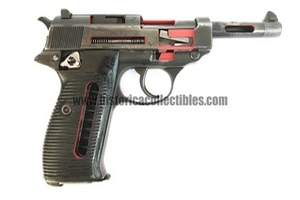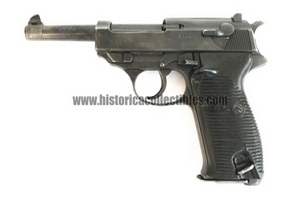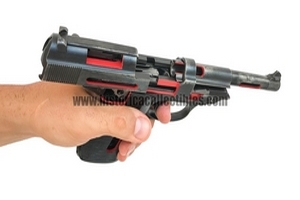Educational Cutaway Pistol Walther P38 Mauser (byf), 1943
Walther P38 cutaway military pistol in 9 Parabellum caliber, produced by Mauser (byf code) in 1943.
This example of a pistol, sectioned and made inert for "educational" use in the workshops inside the military schools, was used to instruct students in the technical learning of its operation.
The sectioned areas of the gun that made the various internal operating mechanisms "visible" include: the closure and locking of the slide, the recoil spring, the barrel, the area of the chamber, the handle to make the magazine elevator spring, and the mechanism for loading and lowering the hammer.
The Walther P38 was born in 9mm Parabellum caliber, it is a pistol initially produced in Germany, since 1938.
It was born from the development of the AP (Armee Pistole) and HP (Heeres Pistole). The same year the pistol was adopted by the German army with the name P38 (from "Pistole 1938, distributed however only from 1940). The P38 is a semi-automatic pistol with a geometric oscillating block lock, single action/double action trigger, external hammer, fixed sights and open slide.
The closure of the weapon is of a stable/geometric type, necessarily not labile given the powerful caliber used. This closure is called "swinging block" (Walther patent). In this model, a machined block of complex shape is placed under the barrel, equipped with two lateral lugs or "tenons"; these create the connection with the trolley, settling, during the closing phase, in two recesses created in it.
During the firing phase, the slide and barrel recoil together for about 8 mm, after which a small piston pivoted under the barrel and with a parabolic profile tip intercepts the frame and presses, on the other side, against a profile plane hyperbolic obtained by milling inside the block itself; this action determines the tilting of the rear part of the block, with the exit of the two tenons from the seats, releasing the barrel and allowing the slide to proceed in its retrograde travel. The presence of two inclined planes, one obtained on the oscillating block and one on the frame, then brings the system back to its initial position when the barrel returns to closing pushed by the action of the two recovery springs.
The slide is made of solid machined steel; it is of the open type and therefore has a very large area useful for the ejection of cartridge cases (thus reducing the risk of a jam resulting from carrying out this operation). It contains the entire safety system and on the left side is the manual safety control; the firing pin is also positioned in the shutter, with its spring, which is of the floating type.
In the lower part of the carriage there are negative guides for coupling onto the frame, which carries the two recovery springs on the guides themselves, one on each side with the relative spring guides. The top of the slide, when open, is closed by means of a pressed steel element equipped with elastic appendages, which also bears the rear sight.
Inside it there is also the chambered cartridge indicator, consisting of a long spring-loaded pin which rests, with the weapon closed, on the bottom of the possibly chambered cartridge and, therefore protruding a couple of mm from the portion of the slide located between the notch and the hammer down, allows the operator to ascertain both visually and tactilely (for example in the dark) the presence of a shot in the barrel ready to be fired.
The stocky and massive extractor is mounted on the left, and on the same side there is the manual safety lever, which performs two important functions.
Rotating the lever downwards causes the rotation of the internal barrel, integral with it, which while with its own appendage intercepts the firing pin (and therefore absorbs its fall), on the other side presses on a lever through a portion of the circumference protruding from the upper part of the frame causing the hammer to fall, which then rests on the firing pin itself without causing the shot to fire.
Finally, the safety, by moving the traction bar on the right side of the frame slightly downwards, disconnects the trigger chain. It is thus possible to disarm the pistol in total safety, and at the same time be ready to fire in double action (once the safety has been removed) by simply pressing the trigger, which will cause the hammer to be raised and subsequently knocked down.
The frame is made of solid machined steel (on some war examples it is made of pressed steel sheet).




